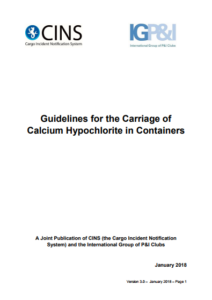The International Group of P&I Clubs (IG Clubs) and the shipping line members of the Cargo Incident Notification System (CINS) have issued a revised version of the Guidelines for the Carriage of Calcium Hypochlorite in Containers.
The Guidelines were first issued in May 2016, with version 2.0 of the Guidelines issued in January 2017 to take account of the package limit of 100lb drums under US measurement as well as the package limit of 45kg net weight.
The Guidelines can be considered “IMDG Code plus precautions” in that they include selected provisions from the IMDG Code plus additional precautions consistent with the science basis established in 1999 by consulting scientists advising the IG Clubs.
The revised version 3.0 of the Guidelines seek to provide continuity in terms of the referencing of the package limit and provide clarity as to the nature of the Guidelines.
At normal temperatures calcium hypochlorite decomposes very slowly and releases heat. However, at higher temperatures the rate of decomposition increases and if the heat is not able to escape from within the material then its temperature increases, along with the rate of decomposition.
A self-accelerating reaction can result in a violent decomposition of the calcium hypochlorite releasing heat and oxygen. This has resulted in serious fires and explosions.
The packaging and quantity can have an impact on self-accelerating decomposition.
The United Nations Manual of Tests and Criteria provides self-accelerating decomposition test (SADT) methods for determining the properties of substances classified as self-reactive. These tests can also be used to evaluate oxidizers such as calcium hypochlorite. The International Group of P&I Clubs advice in this paper is also based on the critical ambient temperature (CAT) method used to determine self accelerating properties.
The IG Clubs are an Advisory Member of CINS and many Club Members are also members of CINS. The IG Clubs encourage other container line members to enquire about CINS membership, the main purpose of which is to highlight and address risks posed by certain cargoes and/or packing failures in order to improve safety in the container liner shipping industry.
You may view the revised guidelines herebelow


































































